These plants evidently have very good genetics ... notice all the growth
above last week's damaged leaves. The intervals between the branches (internodes)
are still narrow at only about 1/4" each which is pretty good for a plant that is 80%
sativa which tends to grow tall and willow-like versus indica's short and
squat stature. Still keeping the plants 6 inches or more from the lights
but monitoring them for excessive stretching as seen at the internodes.
The Triple X has another one of the twisted pre-leaves and so it was moved
up to the primary shelf for the stronger light. The Super Skunk, still green
and swollen but with no further grow, was put back down on the counter.
September 14th: Week 1 (flowering/transition)
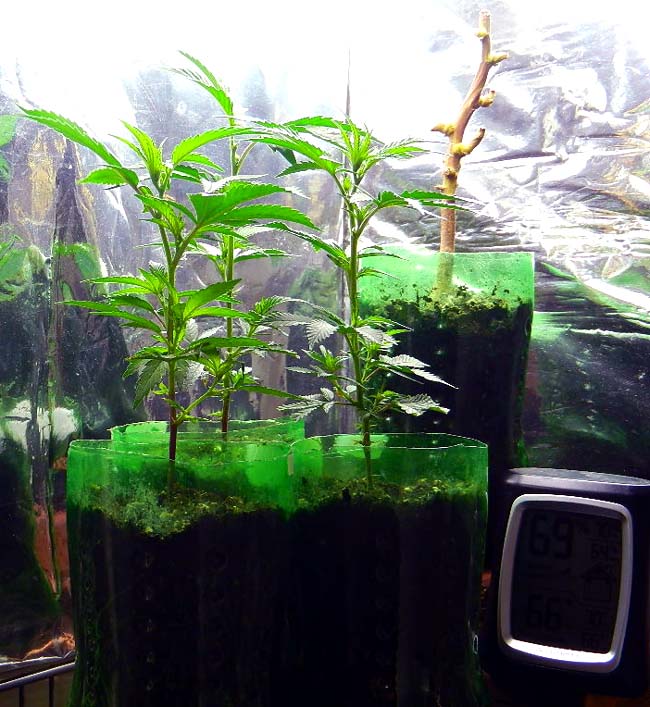
Lots of growth this last week - plants now 6 inches tall. Internodes now at 1
inch intervals. The plant at the rear had to be topped as it was outstripping
the others. Decided to flip the lights last night before they got
much taller as they will double or triple in size during the flowering
cycle.
Another reason for flipping the lights was the appearance of these white pistils at the leaf axils
which is called preflowering and indicate the plant is ready to leave the
vegetative cycle and begin flowering. For some reason these have appeared
in the last three grows within a couple of weeks of bringing the clones home.
I'm wondering if the vegetative grow lights that I use are missing something
from the daylight spectrum even though they are 6500K ... need to investigate
'full-spectrum' bulbs.

I am really pleased with their vigor (notice the extensive root system)
at this stage and look forward to a prolific grow. Went from 1/2 cup water
every two days to 1 cup every three days - which may be a bit much too soon.
I suspect it was over watering and not letting the containers fully dry out
between waterings that stunted the previous grows. Not only are these smaller
containers easier to handle you can also see the condition of the root system.
The Super Skunk mother plant was repotted into a smaller container.
The Triple X lost both of the precursor buds and seemed to have slowed down
so it was placed outside. No sign of emergent buds on the Super Skunk
yet.
September 21st: Week 2 (flowering/transition)

Began feeding with Foxfarm's Tiger Bloom
© at half strength.
The label says it is:
"... an ultra potent, fast acting, high phosphorous fertilizer that also
contains a good supply of nitrogen for growth and vigor. It is formulated
with a low pH to maintain stability in storage and keep micro nutrients available. When
used as directed Tiger Bloom© encourages abundant fruit, flower,
and multiple bud development. Great for Tomatoes!"
I love that last line which I guess is a leftover from the days of
pre-legalization when such colorfully labeled products
were only to be used on 'legal' crops - wink/wink. One of the agricultural
supply houses I use still has a sign on the counter that says if you mention
the "M" word you will be denied service and asked to leave ... they won't
even spell it out.
Due to over watering in the last two grows the roots weren't able to properly
ultilize the nutrients. Hopefully that will no longer be a problem.
Any residual effect of the use of non-organic fertilizers is mitigated by
fully flushing the root zone prior to harvest.
Here are the current pictures. I will begin indicating
the weeks to harvest from the day the lights were flipped which is usually a two week difference.
These plants were flipped 9/13. The one on the right had been
topped two weeks ago in order to slow its growth to keep pace with
the others.
September 22nd: (flowering/transition)
Just when you think you have everything under control something happens to
shake your complacency and offer you an opportunity to enlarge your experience.
Like when I forget how crowded things are in my combo bathroom/grow
room and I move too fast upsetting things.
This morning it was the primary shelf that came down taking all three plants
with it. Two survived intact with a just a little loss of soil. The third
had a branch torn off and the main stem was broken, but not severed, in two
places. I've been told that cannabis is a hearty plant and can bounce back
even stronger from such trauma so I spliced and braced everything back together.
There is a multi budded branch just below the break so at least that much
of the plant should survive. The rest has a case of the severe droops. The
shelf has been secured to prevent such mishaps in the future.
Later: The damage was too extensive for it to bounce back ... it remained
in shock. Since there are only two plants left I've decided to
use the extra shelf area to move them further apart for maximum access to
the available light.
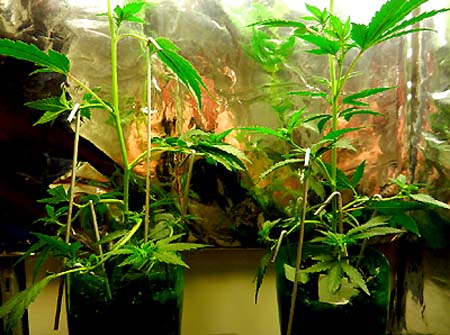
This extra room allows me to do a bit of training in order to encourage
the plant to grow in an open shape rather than as a vertical Christmas tree.
The soft metal 'stakes' are used in hanging chain link fencing. Here they
are used to weight down the side branches so that they grow away from the main
stem.
Some of the lower branches are being trained to encircle the
container as well.
September 25th: (flowering/transition)
Both plants are over twelve inches tall now and closing in on the lights so
the shelf was lowered to accommodate an eventual height of twenty inches.
At the same time I took the opportunity to strip all the reflective mylar
from the walls. Mylar can reflect the light unevenly causing hot spots which
bleach and burn the leaves. In a large room this isn't a problem but in small
spaces like mine the plants are too close to the mylar. The flat white walls
are almost as reflective and a lot more even (doesn't show well in this image).
I also closed down the second shelf and used the T5 tube lights on the back
wall of the primary shelf mounted vertically to supplement the overhead lights.
This will allow for more even coverage for the taller plants so that
the lower buds ripen at the same time as those closer to the overhead lights.
These
four 22 inch 14 watt T5 tubes output a combined 5400 lumens in the daylight
(6500K) or vegetative spectrum as I want the plants to grow some more. After
they have filled out I will switch to soft white (3000K) tubes to assist
in budding. These are in addition to the 4 overhead lights which are 42 watt
CFL twists outputting 11,200 lumens in the warm white spectrum (2700K). The
total available light in the grow room is 16,600 lumens using only a total
of 224 actual watts - the equivalent of a little over two 100 watt incandescent
bulbs with about the same amount of heat. My monthly electric bill increased
between $10.00 - $15.00 running both sets of lights and the three fans.
September 28th: Week 3 (flowering/ first flower)
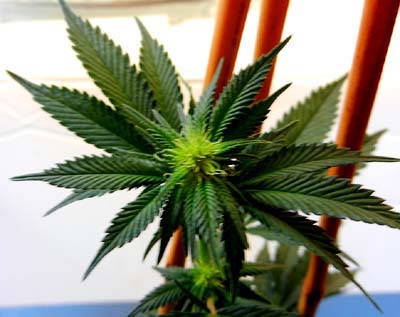
Both plants are beginning to show an increase in pistils and single leaves
at the bud sites which indicates the calyx is now developing and signals
the first week of flowering.
Anticipating a heavy yield - already each plant has over 20 bud sites - I
staked the plants using thin bamboo canes. These canes will confine
and shape growth much like the screens used in the previous grows.
Foxfarm recommends full strength nutrients mix alternate waterings but I
am trying to feed more evenly using 1- 2 cups of 1/2 strength every watering.
Here is their formal portrait at the beginning of their first week of flowering:
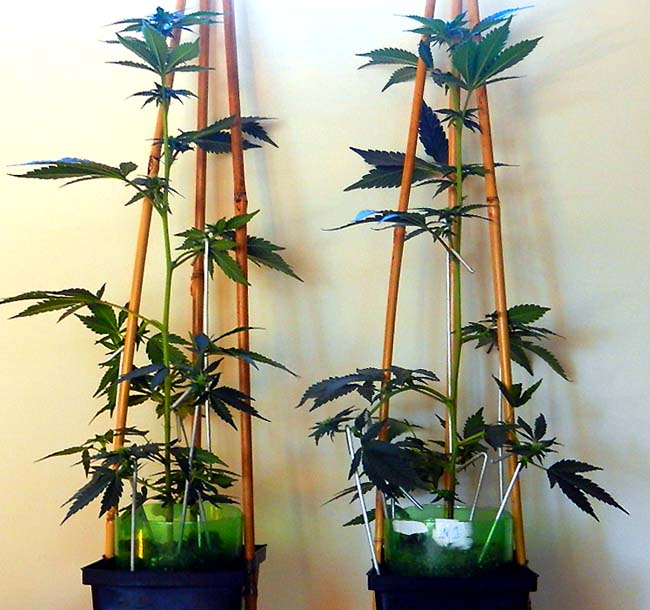
Now that they are flowering I swapped out the daylight spectrum T5's for the
warmer soft white bulbs. The total lumens remains the same and seems to be sufficient. If need
be I could replace the fixtures with 56 watt units but that means more heat
problems and might not be worth the gain in output. Something I will
keep an eye on.
Later the mid-day temps in the grow room went over 95F and the RH dropped to 20%
so I added a 4th fan and temporarily turned off the supplemental T5 lighting which brought the temps
back down to an acceptable 85 degrees.
There is plenty of circulation now with the 14" 950 cfm overhead
exhaust fan, the 10" oscillating tower mounted across from the shelf
and the two 6" fans - one aimed horizontally between the overhead lights
and the plants and the other centered underneath the wire shelf pointing upwards.
In addition there are two filtered air intake vents at floor level with one
drawing fresh outside air and the other warmer inside air. I removed the
humidifier because it rarely gets below the ideal 45-55% range and then only
for a couple of hours in the early afternoons. As long as the plants have adequate
water they can withstand temporary low humidity and higher temperatures.
Recently I started weighing the plants after they have been watered. Today
they weighed 570 and 590 grams respectively. I will weigh them again in 2
days to note the difference which is equal to the amount of water they used.
They will need frequent watering and keeping track of their respective weights will keep me from over or under watering them.
October 5th: Week 4 (flowering/bud growth)

The plants have slowed their vertical growth putting on only one inch in the past week - now they are 15" each.
The big change is their concentration on bud growth. This is the terminal
bud on plant #2. It is already swollen with 1/2" long yellow white pistils
... each one connected to a calyx which is one of the multiple female ovaries.
The buds grow vertically up the stem in clumps of calyx (pl) and each clump
is separated by a ring of small, single leaves so the enlarging bud appears
to be layered.
The pistils
are sticky in order to capture pollen to grow next year's seeds. In this
case though there is no male pollen available (hopefully) and so the bud
will continue to add calyx (pl) without 'going to seed' and will grow larger.
Here they are at the beginning of their fourth week of flowering. Looking
closely you can see at the center of every leaf cluster the yellow white
of the developing calyx.
Today the inside temps went over 95F and the RH dropped
to 16%. Weighed the plants mid afternoon and #1 had lost 8.5 oz since
yesterday morning's watering and #2 had lost 7.5. Each had lost exactly 37%
of its previous weight. Added 2 cups plain water each and brought the weights
back to yesterday's levels (667 grams and 588 grams). Normally they only
need to be watered every other day at this stage. Also I turned off the overhead
lights and boosted all fans to maximum output which managed to hold temps
to the high 80's. I also moved the plants to the front of the shelf which
exposes them to a greater volume of circulated air.
October 12th: Week 5 (flowering/bud growth)
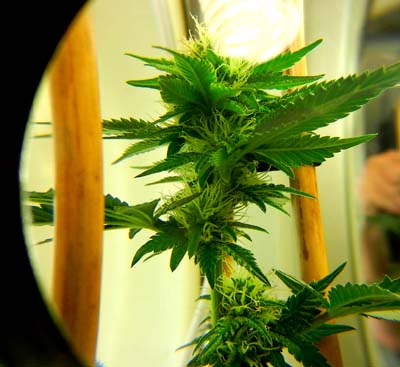
Both plants have put on another inch in growth and are now 16" tall. This
is the terminal bud on plant #2. Compared to last week it is a bit
fuller and a 1/2" taller.
The really impressive bud growth comes in the last 4 weeks especially the
last two. At Week 6 I will start supplementing the nutrients with a
bud booster to enhance growth.
I'm glad that I started weighing the plants before and after watering ...
I should have instituted this elementary feedback control earlier and I might
not have lost so many due to under or over watering.
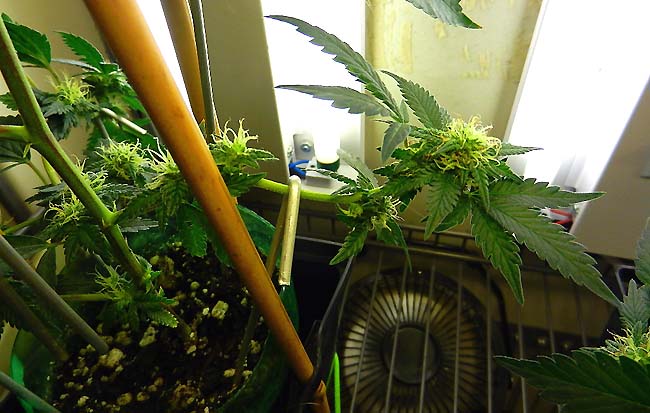
There seems to be two separate areas of growth on each plant ... the upper
part has the buds growing close to the stem whereas on the lower six inches
the lateral branches elongate and each branch has many little buds.
These
lower branches are actually the oldest and thus the farthest from the light.
With the addition of the vertical back lights they've finally had a chance
to stretch. I believe the little buds are called 'popcorn buds' which don't
get as large as the end or terminal buds.
I was just reviewing the number of days flowering for this strain. It is
58 - 68 days with an average time to harvest of 63, Since I calculated the
initial week of flowering starting September 28 the harvest will be between
November 24th and December 4th. So basically between Thanksgiving and my
birthday.
I plan to harvest the main colas on the top half of each plant first and
then move the shortened and more bushy bottoms closer to the overhead lights
for the final 2 weeks. These lower branches have been trained horizontally
away from the center so they will present a rather even height canopy similar
to previous grows.
And it all should be cured in time for Christmas.
October 19th: Week 6 (flowering/bud growth)
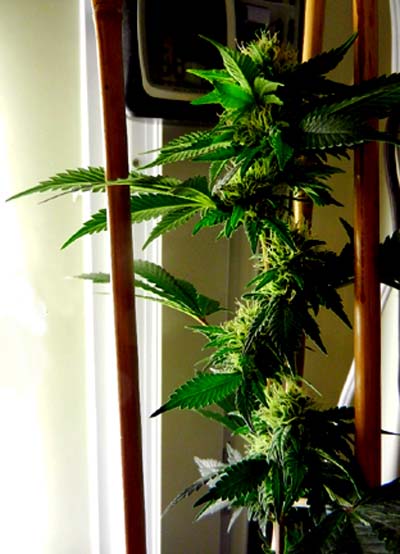
Interesting development that I am still researching: about 10-20%
of the pistils on both plants are turning brown and shriveling up. This happened
on the the previous grow as well right around the 4th week (those were
indica dominant strains which have a two weeks shorter flowering cycle than the sativas). It's
not localized to any particular part of the plant occurring on new buds as
well as the older lower buds. So far I've learned that it can result from:
1. Pollination. 2. Hermaphrodization (plant adding male sex organs and
self pollinating) caused by stress 3. Fertilizer burn 4. Plants
nearing harvest (possibly as they are 3 weeks from harvest).
Previous grows produced no seed so I'm ruling out pollination and there are
no signs of the plants changing sex. I've been careful on the fertilizers
but there was a tiny bit of leaf burn last week. I flushed the plants with
plain water for 2 cycles and them resumed the alternate nutrient feeding.
This week I added Foxfarm's Big Bloom© to the mix and the first feeding
was yesterday. Because this increases the nutrient load the first few feedings
will be at half strength while I check to see how well it is tolerated.
There are two more possibilities:
1. The pistils, which are very
tender, were damaged during the past week's extremely low relative
humidities ... there were several days where the RH dropped below 20%. In
order to protect against future drops I reinstalled the humidifier and set
the humidistat (digital controller) to 45%. I also attached the below shelf
fan to the humidistat. When the humidifier on the floor is activated the
fan will help draw the humid mist up off the floor and into the plants above.
2. I've just read that over handling and squeezing of the buds when checking
growth can injure the pistils causing them to prematurely die. That would
explain why only the larger outside buds are damaged. I am seeing some new
growth on those buds so hopefully maybe all is not lost at this point.
I've also noticed that when the lower fan was on full time, without
the extra moisture provided by the humidifier, the lower leaves would dry
out and then tear from being tossed in the breeze from the fan. We'll see
if this is an improvement. The oscillating tower was dropped down to its lowest
setting as well ... the objective here is to circulate the air in the
grow room and gently ruffle the leaves and stems which promotes stronger stem
growth. I think at the higher level it was contributing to the desiccation
and leaf tearing. The 6" fan placed between the lights and the plants was
also on full time and so it was plugged into the timer and now will only
turn on when the lights are on. Now all the fans in the grow room are
controlled either by temperature (directly or indirectly) or relative humidity.
October 26th: Week 7 (flowering/bud growth)
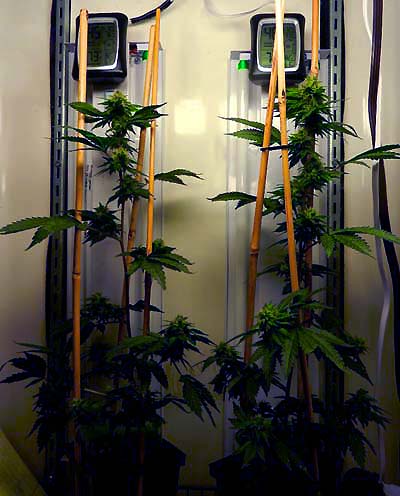
As you can see from the
table at the top we are now at Week #7 or Day 43 of the blooming cycle. Notice
how the plants almost tripled in size during the 'stretch' or the first 30
days following the flip to a 12/12 light cycle.
The flowering period for Blue Dream is between 58-68 days with an average
of 63 days to harvest.
There are two ways to count: either from the
day the lights are flipped or from the day the plants show first flowers.
I am using both styles in this table. The final determination as to when
to harvest is made based on a study of the trichomes (resin glands) under
magnification starting around the 6th week.
Click
here to see an example from a previous
grow.
Here are some more interesting facts: Since October 1st container #1 has
gained 4.5 ounces and now weighs 680 grams wet while #2 picked up 3.21 ounces
and weighs 595 grams wet. Currently both plants take 2 cups of liquid at
each feeding. The containers originally weighed 350 grams wet before the
plants were added and I've been wondering why container #1 is so much heavier
than #2. So I used a probe to determine the moisture content and discovered
that the last 2" of #1 are saturated at 100% indicating poor drainage. I
used a hanger to open up the holes in the bottom and will let it dry down
to roughly equal to #2 which was was not saturated at the bottom. That might
explain why #1 was growing slower.
The top colas now are each 6" tall and consist of 6 different
bud sites growing together one above the other. Here is a picture of plant #2's cola filling in.